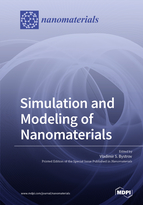Simulation and Modeling of Nanomaterials
A special issue of Nanomaterials (ISSN 2079-4991). This special issue belongs to the section "Theory and Simulation of Nanostructures".
Deadline for manuscript submissions: closed (1 November 2021) | Viewed by 38092
Special Issue Editor
Interests: computational molecular modeling; molecular dynamics (MD) simulations; molecular mechanics, quantum-chemical calculations (ab initio, semi-empirical methods, density functional theory (DFT) methods, including, DFT with combined hybrid functionals); computational materials science and bionanomaterials; nanomaterials; surface; interface; self-assembly; amino acids and peptides; nanotubes; nanoparticles; polymers; piezoelectrics; pyroelectrics; ferroelectrics and bioferroelectrics; two-dimensional materials; carbons, graphene and graphene oxide; composite nanomaterials
Special Issues, Collections and Topics in MDPI journals
Special Issue Information
Dear Colleagues,
Fast progress in nanoscience is closely related to the development and application of computer methods in this field. The development of modern computer modeling and contemporary computational methods of simulation and structure and property calculations of nanomaterials leads to the inevitable development and rise of the works on computer simulation and modeling in investigations of many various types of new nanomaterials, which allows reducing the cost for their design and significantly increasing the efficiency of the creation of such new and very necessary nanomaterials, which is extremely important. At present, computational modeling and simulation have become the main leading approach when creating new materials with predefined properties. This approach allows us to select the optimal parameters for the nanomaterials themselves (and predict their physical properties, characteristics, and behavior under the different conditions) and determine the parameters for the technologies for their practical manufacture.
This new Special Issue focuses on computational detailed studies (simulation, modeling, and calculations) of the structures, main properties, and peculiarities of the various nanomaterials (nanocrystals, nanoparticles, nanolayers, nanofibers, nanotubes, etc.) based on various elements, including organic and biological components, such as amino acids and peptides, etc. For many practical applications in nanoelectronics, etc., such materials as ferroelectrics and ferromagnetics, having switching parameters (polarization, magnetization), are highly requested, and simulation of dynamics and kinetics of their switching are a very important task. Another important task for these studies is also computer modeling, as well as research on the composites of these nanostructures with polymeric ferroelectrics and various graphene-like 2-dimensional structures and their properties.
For this Special Issue, we seek computer modeling, molecular modeling, and numerical studies of nanomaterials carried out through various contemporary methods using molecular mechanics (MM), quantum chemical calculations (QM), including semi-empirical approaches, density functional theory (DFT), and molecular dynamics (MD), using multiprocessor clusters (with high-level software, such as VASP).
Dr. Vladimir S. Bystrov
Guest Editor
Manuscript Submission Information
Manuscripts should be submitted online at www.mdpi.com by registering and logging in to this website. Once you are registered, click here to go to the submission form. Manuscripts can be submitted until the deadline. All submissions that pass pre-check are peer-reviewed. Accepted papers will be published continuously in the journal (as soon as accepted) and will be listed together on the special issue website. Research articles, review articles as well as short communications are invited. For planned papers, a title and short abstract (about 100 words) can be sent to the Editorial Office for announcement on this website.
Submitted manuscripts should not have been published previously, nor be under consideration for publication elsewhere (except conference proceedings papers). All manuscripts are thoroughly refereed through a single-blind peer-review process. A guide for authors and other relevant information for submission of manuscripts is available on the Instructions for Authors page. Nanomaterials is an international peer-reviewed open access semimonthly journal published by MDPI.
Please visit the Instructions for Authors page before submitting a manuscript. The Article Processing Charge (APC) for publication in this open access journal is 2900 CHF (Swiss Francs). Submitted papers should be well formatted and use good English. Authors may use MDPI's English editing service prior to publication or during author revisions.
Keywords
- nanomaterials
- nanotubes
- nanoparticles
- domains
- polymers
- piezoelectrics
- pyroelectrics
- ferromagnetics
- ferroelectrics and bioferroelectrics
- two-dimensional materials
- carbons and graphene and graphene oxide
- composite nanomaterials
- surface
- self-assembly
- amino acids and peptides
- modeling
- molecular dynamics (MD)
- molecular mechanics (MM)
- quantum-chemical (QM) calculations (ab initio, semi-empirical methods, density functional theory (DFT))
- machine learning and artificial networks
- computational materials science







